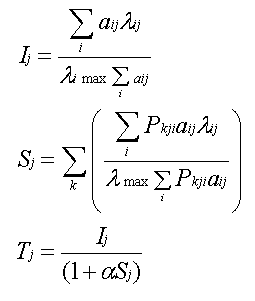For each sphere, a aggregate rating { I j } for each sphere is first computed by adding up that sphere?s weighted scores (i.e, rating multiplied by importance level -? low = 1, medium = 2, and high = 3). These are "normalized" with respect to the maximum possible scores to get a result between 0 and 1. The internal score is then "attenuated" based on the level of influence from other spheres. In principle, the legitimacy of any given sphere can be affected by nearly any other--the level of influence is something that advanced users may decide to alter. Computationally, these influences are currently hard-wired to play only a small role in altering the final legitimacy score, but this effect may be changed in future versions based on suggestions from users.
The internal calculations carried out are as follows:

Where the variables are defined as follows:
i is an index over the institutional arrangements (total of 12 to 15 for each sphere)
j and k are indices over the spheres (total of 8),
Tj is the legitimacy of a given sphere j.
Ij is the weighted aggregate rating of the institutional arrangements for sphere j,
Sj is the cross-sphere interaction, reflecting the degree of influence on sphere j of institutional arrangements for the other spheres, k≠j
Pijk the degree of influence on sphere j of institutional arrangement k for sphere i
λij (lambda) is the rating (1-10) for a given institutional arrangement i and sphere j,
λmax (lambda max) equals 10, a normalizing factor,
aij is the level of importance for a particular question (assigned 1,2,or 3 for low, medium and high, respectively) for a given instituational arrangement i and sphere j,
α (alpha) is a weighting factor (currently set at 0) reflecting the degree of 'attenuation' caused by interactive effects between spheres (currently, that can be adjusted only within the program).



